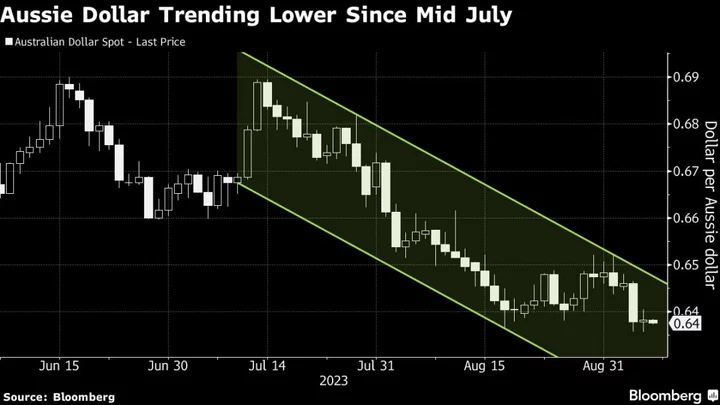Investors betting Australia’s dollar will continue to weaken may want to reconsider. Analysts see the currency rebounding on China stimulus and Reserve Bank of Australia rate-hike prospects.
The Australian dollar fell to a 10-month low of 63.57 cents versus the greenback last week, with asset managers holding a record net short position of 94,107 contracts on the currency. Growth concerns in China, the nation’s largest export market, and higher US yields have made it the worst-performing G-10 currency this quarter.
But the Aussie is poised to rally in the coming weeks, ending the year at 66 cents and reaching 68 cents by March, according to a Bloomberg survey of strategists and economists. The outlook is seen improving as China is taking measures to boost its economy, while the RBA may go for another rate increase by December, showed a separate Bloomberg survey.
A potential final rate hike by the RBA is currently underpriced by markets, said Simon Harvey, head of FX Analysis at Monex Europe in London. “In the fourth quarter, Chinese officials are more likely to embark on more direct stimulus should the 5% growth target seem unattainable, which would immediately boost risk sentiment,” he added.
The Aussie dollar may come back under pressure if data on Sept. 14 shows the nation’s unemployment rate rose by more than expected, as the weakening labor market may spur investors to unwind their expectations of another RBA rate increase.
Domestic factors aside, given the Australian dollar’s correlation with the yuan, Macquarie Group sees it benefiting from China’s policies, such as influencing the markets to discourage yuan selling, and prospects of Federal Reserve rate cuts in 2024.
The Aussie’s downside may be limited as many negatives are priced in and AUD/USD is “already looking undervalued relative to its short-term and especially long-term value,” said Valentin Marinov, Head of G10 FX research & strategy at Credit Agricole CIB in London.
Here are the key Asian economic data due this week:
- Monday, Sept. 11: Malaysia industrial production
- Tuesday, Sept. 12: Australia consumer and business confidence, New Zealand retail card spending, India CPI and industrial production
- Wednesday, Sept. 13: Japan PPI, BSI large all industry 3Q
- Thursday, Sept. 14: Australia employment change and unemployment rate, Japan industrial production and core machine orders
- Friday, Sept. 15: China 1-year MLF, retail sales, industrial production and fixed assets ex-rural, New Zealand business manufacturing PMI, Indonesia trade balance, Philippine overseas remittances

